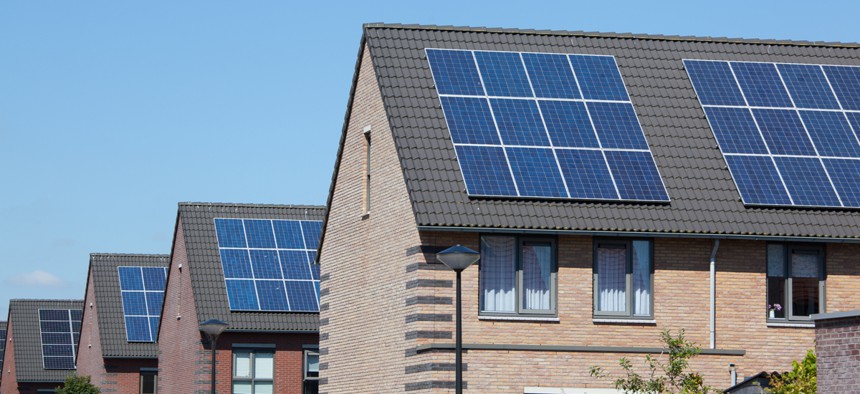Rising Sun: Solar Energy Growing Across the Country

Solar-friendly environments are springing up in places you might not expect. SHUTTERSTOCK
COMMENTARY | Solar energy is taking off across the country, including in places that aren't obvious homes for alternative energy, as state and local governments see its benefits.
Solar energy is here to stay, and it’s growing in places you might not expect. States like West Virginia and Ohio, where fossil fuels have been the stalwarts of energy production for decades, are seeing a rise in solar installations.
Why the rise in solar? Solar energy helps us strengthen the resilience of our electric grid. When more solar electricity is generated, the whole electric grid works smarter, stronger and more efficiently because solar can be economically produced closer to the source of demand and when the need is greatest—during the day. Solar energy also reduces our dependence on foreign oil, helping to protect our national security interests.
More and more, communities are realizing that solar helps create local jobs, improves the energy system and provides reduced utility costs and tax benefits to homeowners.
Just ask Robert Fernatt of Falling Waters, West Virginia and Cari Orris of Stow, Ohio. Fernatt and Orris are just two of the hundreds of solar homeowners across the country who opened their doors and hosted their neighbors as part of the National Solar Tour, a nationwide event where hundreds of homeowners and businesses conduct open house tours of energy-efficient and solar-powered buildings to showcase the benefits of solar.
In 2017, Fernatt installed a roof-mounted solar array powering an all-electric house and two electric vehicles. The result: his monthly power bill is only $5.
Orris reduced her electric bill almost 66% in the last year after she installed 20 solar panels on her roof. Since then, the highest Ohio Edison bill she received was $73. Last July, Orris received a $5 credit instead of a bill.
Beyond the bill savings for individual solar homeowners, solar electricity benefits the entire community. More solar use creates jobs, which boosts the local economy. According to the Solar Foundation, the solar industry now employs 250,000 Americans across the country—an increase of 168% in the past seven years from about 93,000 jobs in 2010. These jobs range from salespeople to solar installers on rooftops. These are solid local jobs that can’t be outsourced.
Additionally, solar is providing secondary income for farmers. Farmers are putting bee and other pollinator habitats under solar panels mounted on their land to help pollinate crops around the area. Panels can also be installed over brownfields to turn once fallow land into something productive and revenue generating. This also provides additional tax revenue to communities. For instance, properties with solar facilities in North Carolina paid almost $10.6 million in property taxes in the year after the facilities were developed compared to only $513,000 the year prior—a nearly 2,000% increase, according to the North Carolina Sustainable Energy Association. Further, local and state jurisdictions benefit from other tax revenues, including sales taxes paid on solar equipment purchased, business and professional license taxes paid by solar services providers and business property taxes.
Solar energy adoption in the United States is on track to more than double in the next five years. Helping to spur this growth are governments that are working to create a level playing field for solar. In other words, state and local government leaders are reexamining existing regulations to create more opportunities that enable solar owners to earn fair tax credits for the electricity they generate, and to easily and cost-effectively install solar panels on their properties.
Just look to Miami-Dade County, Florida as a prime example. Until recently, the Miami-Dade County Commission had several regulatory hurdles in place that made it difficult to get the necessary permits to install solar panels. The permit process could take months—costing interested solar customers and installers time and money. Eventually, a group of solar homeowners banded together and demonstrated the value-add of solar to the county commission, which revised its permitting process to encourage greater solar adoption in the county. As a result of removing this barrier to entry, more residents are examining solar as an energy option and when they are ready to make the leap are receiving their permits within days.
The prospect for solar energy is bright—pun intended. The benefits have increased exponentially and show no signs of slowing down. State and local governments would be wise to continue to build solar-friendly environments so that homeowners and businesses can receive and spread those benefits community-wide.
Anya Schoolman is Executive Director of Solar United Neighbors, the national organization representing the needs and interests of solar owners across the country. Larry Ward is the Midwest Regional Director of the Conservative Energy Network, a non-profit coalition of 21 state members focused on advancing conservative free-market clean energy solutions at the state and local levels.
NEXT STORY: Why Some Hawaiians Are Fighting a Massive Flood-Control Project





